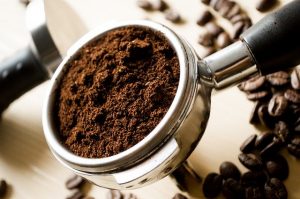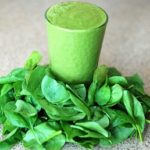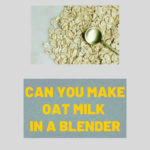Anyone who owns a blender and who also loves coffee will eventually wonder if you can grind coffee beans in a blender? The question might come up when you get a gift of organic coffee beans for Christmas, or you might be in the supermarket and see a sale on Peruvian whole beans and wonder what they taste like.
The classic method of grinding coffee beans was to use a store grinder. That’s probably what your parents and grandparents grew up using. These work fine, but the problem with them is that you have to grind all of your coffee when you buy it. That’s ok if you are not buying a lot of coffee, but if you are planning on buying a decent amount, it will lose it’s freshness.
My pick for anyone looking to grind coffee beans is this hand cranked burr coffee grinder.
That is why most coffee aficionados end up buying a stand alone coffee grinder. These are stand alone appliances that you keep in your kitchen and can use every morning when you grind your morning coffee beans. There are a few downsides however.
- They take up extra space.
- And they can be costly and tricky to use.
- Many of them are a bit fragile (the electronic type) and the manual ones can be a pain to use.
You’re essentially crushing and grinding (using a burr grinder) the beans by hand. This is fine if you’re a coffee purist or you are only making coffee occasionally, but if you are someone who wants to have a lot of coffee and you do not have the time to set up a coffee grinder, then it can be bothersome. That’s why most people use the electronic coffee grinder even though the hand burr grinders are superior.
But what if you don’t own a coffee grinder? What if you only have a blender? Can you blend coffee beans with a blender?
Sure! I use my Ninja blender to do just that. You might own a Ninja blender and wonder if you can just dump the beans in the blending jar and turn it on and end up with fresh coffee grinds. Well, you can. You will end up with a coarse grind, but it’s totally fine.
In fact, if you happen to use a french press coffee maker, then a coarse grind is preferable. One reason is that fine ground coffee leaves a lot of sediment and you don’t want that when you make French Press. I have a whole article detailing whether or not French Press coffee is even healthy.
How Do You Grind Coffee Beans In A Blender?

It’s really quite simple. Take the fresh whole coffee beans and dump them into a dry blending jar (the dry part is essential). Then hit blend and leave it alone for a couple of minutes. It doesn’t take as long as when you are blending almonds or other nuts, but it does take a couple of minutes (2-3).
Stop the blender along the way to take a look at the status of the coffee beans. You want to make sure that you don’t have them clumped up for any reason.
If you get a standard 12 ounce bag that many supermarkets sell, then I would recommend adding about half to your blender. That way you don’t overfill the blending jar.
If you have a bullet blender, then you will have to adjust and add less.
Tips For Grinding Coffee Beans In A Blender
- Make Sure The Blending Jar Is Dry
- Don’t Overfill The Blender
- Use the Low Setting and Pulse To Finish
If you insist on grinding your coffee beans in a blender, and it is not something I recommend, then you have to grind for longer (of blend in this case) then you would with a standard coffee grinder. The blender blades are not the same as burr grinders.
What’s The Best Blender For Grinding Coffee Beans
I wouldn’t recommend buying a blender if your only looking to grind coffee beans. If you are not planning on making green smoothies, nut butter, fruit smoothies, or even blended drinks, then you shouldn’t just get a blender to grind coffee beans.
If you’re only looking to grind coffee beans, then get a good burr grinder.
However, if you happen to have more than one blender (some people have a small bullet blender, plus a larger jar blender such as a vitamix or Ninja) then you are best suited using the larger blender.
Smaller bullet style blenders are not as powerful as ninja blenders or vitamix blenders, and you won’t get as good a grind.
Blenders Don’t Come With Grinder Settings or Grinder Attachments?

Unfortunately there is a lot of misinformation online about blenders and what they can and cannot do. For one thing, blenders don’t come with grinder attachments. They are not designed to be grinders, so you shouldn’t waste your time scouring the internet for that ever elusive blender that has a grinder setting.
You have two options. The first is to get a dedicated grinder. A coffee bean grinder would be best. These are designed to expertly grind whole coffee beans (you might also consider a spice grinder if a coffee bean grinder is not available).
The second option is to use a blender to grind your coffee beans. You will likely end up with a coarse grind, which is fine, especially if you are using a french press as I mentioned above. If you really like a fine grind (perhaps you use a pour over method), then you can simply keep the beans blending for a longer time.
I use a low speed on my Ninja blender when I am grinding coffee beans, and the result is a nice coarse grind. If you are using a Vitamix, then you might want to keep the dial on low. I find that when grinding coffee beans with a blender, it’s better to give it more time then to rush the process with a higher speed.
What Does the Coffee Bean Grind from a Blender Look Like?

If you do end up using a blender to grind coffee beans, you’re going to end up with a very coarse roast. Unless you are using a lux high end blender like a Vitamix or Blendtec, you’re going to get a large grain coarse roast. It’s not ideal.
I’ve made freshly ground coffee in my Ninja blender, but I found that it’s not as fine a ground as I like.
I would totally recommend that you use something such as a small burr grinder if you are purchasing whole coffee beans. These burr grinders produce a finer grind and are simply better at grinding coffee.
And from my experience, even the smallest and cheapest coffee grinder is going to be better at making freshly ground coffee.
If you are going to belnd( or rather, grind) your own coffee beans, then I would highly suggest that you use organic blenders. Here are a number of scientific studies that review the reasons why coffee–and in specific organic coffee–is good for you:
Does it Matter What Type of Coffee You Make?
I would suggest that you avoid French press coffee, there are some serious reservations about it’s health. I wouold go for a drip coffee, or a pour over using paper filters. There’s some good research that paper filters keep out the oil that can cause cholesterol. I suggest these filters (choose the ones that are not treated with chemicals). Here’s a popular one you can find in most stores and online.
Related Posts

Hi Everyone!
Jenny O’Brien here. Nutritionist & personal trainer. Just your average vegetarian and smoothie fanatic!
If you have any questions, or you’d like me to cover a particular topic, drop me a line and let me know!
Thanks!





